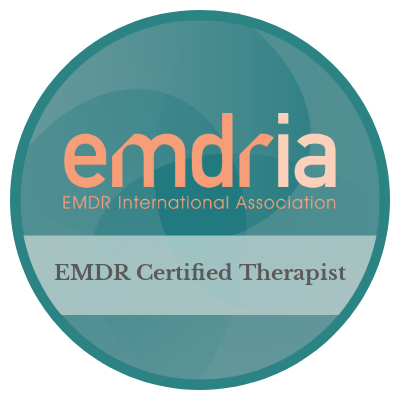Treatment Approaches:
Eye Movement Desensitization and Reprocessing (EMDR)
Eye Movement Desensitization and Reprocessing (EMDR)
Eye Movement Desensitization and Reprocessing (EMDR) was discovered by Francine Shapiro in 1987 when she first recognized the effects of eye movements while thinking about disturbing memories.

One of EMDR’s advantages is that it can be used in either a focused, short-term treatment capacity, or a long-term, broad form of therapy.
The EMDR treatment approach is integrative; it incorporates elements of psychodynamic, cognitive, experiential, and behavioral therapies.

EMDR also gives the body a central place in the therapy.
When you engage in EMDR, you will use “bilateral stimulation,” or BLS. such as eye movements, or any visual, tactile, or auditory stimuli presented in rhythmic left-right patterned movements)
How Does EMDR Work?
The Adaptive Information Processing (AIP) Model
EMDR is guided by the Adaptive Information Processing (AIP) model. The AIP model is a theory about how we learn; it says that when we learn new information it is stored in memory networks that we already have in our brain. Information in our memory networks then form the bases of our perceptions, attitudes, and behaviors.
What??
Ok. Imagine you are in a new situation. Your body and brain use all five of your senses to understand what’s going on; you are seeing, hearing, smelling, touching, and possibly tasting what is going on around you. Your brain takes that sensory information and tries to understand it by thinking about similar situations or events you have experienced in the past. Our brains want to link, integrate, and connect new information with related, previously-stored information. The AIP model calls these invisible connections in our brain, “memory networks.”
However, problems occur when this new experience is not processed correctly; it doesn’t link up and get stored in its proper memory network in our brain. EMDR believes that upsetting experiences, or trauma, does just this: Traumatic events can’t find an existing memory network. Then, because traumatic events are unable to connect to an existing memory network, the memory of the trauma gets stored in the wrong place – the wrong memory network – in our brain. And that makes it harder for our brain, and our body, to understand and integrate the memory and information.
EMDR’s AIP Model believes that dysfunctionally stored memories lead to undesired behaviors and maladaptive responses.
In other words, traumatic events and experiences that don’t get stored in our brain in the right place can cause us to experience distressing trauma responses. Trauma responses range from upsetting thoughts, emotions, behaviors, and body sensations.
EMDR works to access those incorrectly stored memories, process them, and then help them link to the correct or adaptive memory networks. Once this process is done, we should have adaptive behavioral and emotional responses. In other words, EMDR helps the memory of the traumatic event move from being stored incorrectly in isolation in the brain to be stored correctly in an adaptive, existing memory network.

EMDR believes that our thoughts, emotions, behaviors, and way that our body feels are influenced by our brain’s ability to take in new experiences and store the information about these new experiences with existing memories, or “memory networks.”
Does EMDR Work?: The Evidence
According to the National Center for PTSD, EMDR has earned the highest recommendation for treating PTSD across most clinical practice guidelines in the United States including those from:
EMDR is also recognized internationally as an evidence-based and effective treatment for PTSD and trauma by:
EMDR is still considered a “newer” treatment, but the amount of research we have on EMDR’s effects on reducing PTSD and trauma symptoms is growing. Current research shows that EMDR works as well as – and lasts as long as – older, more researched therapies such as CBT. Some research even shows that EMDR has similar effects in managing and reducing PTSD and trauma symptoms as medication.
EMDR is offered in-person in Madison, Wisconsin as well as via telehealth.
At HEART Counseling Robin Kinney, Amberly Stevens, Julie Jensen, and Erin Neill are trained in EMDR.
Dr. Erin Neill is an EMDRIA Certified TherapistTM and an EMDRIA Approved Consultant in TrainingTM under Dr. Rachel Weaver through the Institute for Creative Mindfulness.
If you are a clinician interested in EMDR Consultation, please contact Dr. Erin directly.






